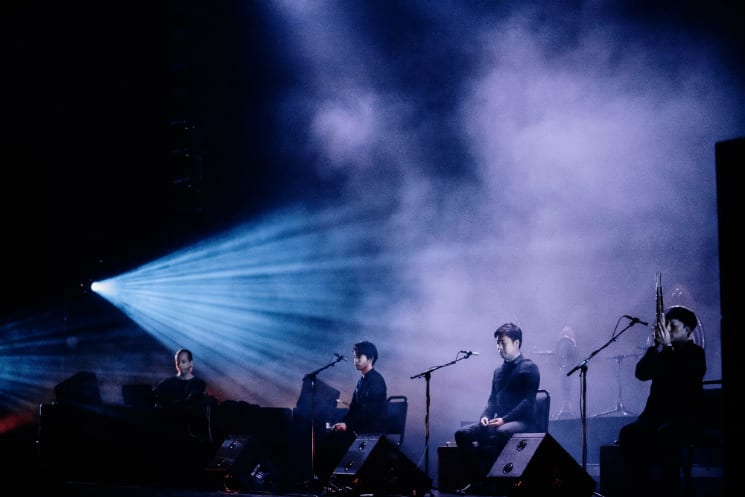The main draw for Wednesday night's (August 21) showcase at Théâtre Maisonneuve, fans eagerly rushed in to hold down spots for Tim Hecker and his Konoyo Ensemble's general admission performance at Montreal's massive 1400-seat theatre, many venturing up to the venue's balconies to take in the spectacle from above.
While Hecker is known to permeate his performance environments with fog and play in distant obscurity, on the massive stage at Théâtre Maisonneuve, the mists had plenty of room to dissipate, preventing a complaint Hecker's previous performances with the gagaku players in his Konoyo Ensemble have repeatedly invited: that is was always difficult to visually confirm where one player's contribution began or ended, their motions and positions on the stage shrouded in a cloudy veil. On his two albums with the ensemble, Hecker's torrential processing moulded their contributions into something far flung from gagaku's imperial court music trademarks, and this live show finally provided a glimpse into their process.
The Théâtre Maisonneuve performance highlighted the stately intentionality of the partnership's dynamic, the gagaku performers rotating between six posts: three stationary percussion instruments along the back and three seats in the front where players performed on traditional implements like the hichiriki, ryūteki and shō. Occasionally providing droning vocal takes, Hecker processed and responded with synthesizers and a laptop to the side, while Kara-Lis Coverdale tended keyboards at the opposite end of the stage.
The widescreen glory of it all rushed over you with dramatic intensity, the gagaku players providing notes in modest but beautifully extended gestures, Hecker making them immense while contributing to a richly dense sound tapestry, thunderous, elephantine bass rattling audiences in their seats while sharpened woodwind performances pinned them in place.
While Hecker is known to permeate his performance environments with fog and play in distant obscurity, on the massive stage at Théâtre Maisonneuve, the mists had plenty of room to dissipate, preventing a complaint Hecker's previous performances with the gagaku players in his Konoyo Ensemble have repeatedly invited: that is was always difficult to visually confirm where one player's contribution began or ended, their motions and positions on the stage shrouded in a cloudy veil. On his two albums with the ensemble, Hecker's torrential processing moulded their contributions into something far flung from gagaku's imperial court music trademarks, and this live show finally provided a glimpse into their process.
The Théâtre Maisonneuve performance highlighted the stately intentionality of the partnership's dynamic, the gagaku performers rotating between six posts: three stationary percussion instruments along the back and three seats in the front where players performed on traditional implements like the hichiriki, ryūteki and shō. Occasionally providing droning vocal takes, Hecker processed and responded with synthesizers and a laptop to the side, while Kara-Lis Coverdale tended keyboards at the opposite end of the stage.
The widescreen glory of it all rushed over you with dramatic intensity, the gagaku players providing notes in modest but beautifully extended gestures, Hecker making them immense while contributing to a richly dense sound tapestry, thunderous, elephantine bass rattling audiences in their seats while sharpened woodwind performances pinned them in place.




